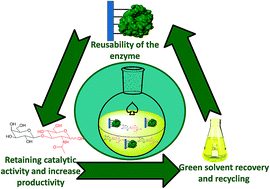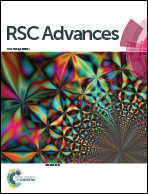Stabilization of β-Gal-3 ATCC 31382 on agarose gels: synthesis of β-(1→3) galactosides under sustainable conditions
Abstract
β-Gal-3 ATCC 31382 (β-Gal-3) was immobilized by multipoint covalent attachment on an agarose support using different enzyme orientations on its surface. The derivatives that showed more activity and stability were the ones bound to a Lys rich region on a monofunctional glyoxyl-agarose (GA) support. Also, immobilization was performed using a Glu + Asp rich region on a heterofunctional amino-glyoxyl-agarose (AMGA) support. The immobilized enzyme was characterized in terms of optimal pH and thermal stability, and its catalytic efficiency was tested on the synthesis of β-(1→3) galactosyldisaccharides. Reactions were performed in the presence of green solvents ([Bmim][PF6] and 2HNND) with maximum conversion and maintained regioselectivity. Reusability assays under identical reaction conditions were also performed to find that GA immobilized enzyme retains about 90% of its activity after six batches with conversion yields above 75% when [Bmin][PF6] was used as reaction media. Furthermore, green solvent recovery and recycling are achieved retaining catalytic activity and increased productivity.



 Please wait while we load your content...
Please wait while we load your content...